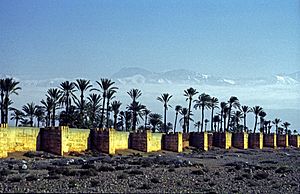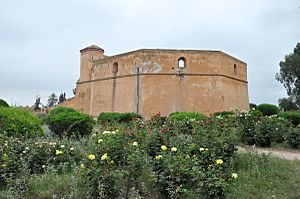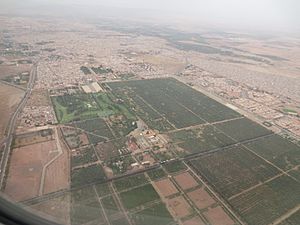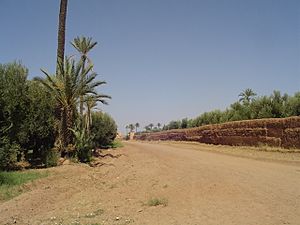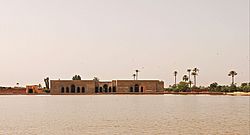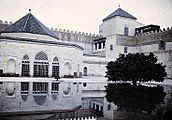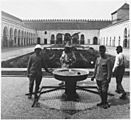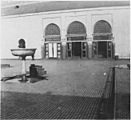Agdal Gardens facts for kids
The Agdal Gardens are a huge area of old gardens and fruit farms in Marrakesh, Morocco. They are located south of the city's historic royal palace, called the Kasbah. In 1985, UNESCO named the Agdal Gardens a World Heritage Site. This was done along with the old city (the medina) and the Menara Gardens. These gardens have several old water pools and beautiful palaces. Two famous ones are the Dar el-Hana and the Dar al-Bayda.
Contents
What Does "Agdal" Mean?
The name Agdal comes from the Tamazight (Berber) language. It means a "walled meadow" or a summer pasture for animals. You can find this same name for similar walled parks in other old Moroccan cities. These include Fez, Meknes, and Rabat.
History of the Gardens
Creating gardens outside the city started early in Marrakesh. The Almoravids founded Marrakesh in 1070. They built many gardens and lakes outside the city walls. These were often called buḥā'ir, meaning "little seas," because of their large water basins.
Built by the Almohads
The Agdal Gardens we see today were first made by the Almohads. This was during the rule of Abu Yaqub Yusuf (1163–1184). The biggest water pool in the gardens, called the Dar al-Hana reservoir, dates from this time.
An engineer from Al-Andalus named Ahmad ibn Muhammad ibn Milhan designed the gardens. He was of Berber origin. The gardens were first known as al-Buḥayra or al-Bustan.
Later, Abu Yusuf Yaqub al-Mansur built the Kasbah, the new royal palace, south of the city. Its southern gate, Bab al-Bustan, led to these gardens. Originally, the garden walls were not connected to the Kasbah walls. There was an open space between them.
The Dar al-Hana complex, with its large pool and a palace, was part of the original Almohad design. It had its own walled area inside the bigger gardens. Only the huge water pool itself from this time has survived. It has been repaired many times over the years.
Saadian Revival
Over time, the gardens would sometimes decline if not cared for. They would dry up and turn into desert. When new rulers took over, they had to replant the gardens and clean the water systems.
After the Almohads lost power, Marrakesh was no longer the capital. The gardens went through a period of decline. It was only in the 16th century, under the Saadian dynasty, that the city became the capital again. The Kasbah and the gardens were then restored. During this time, the gardens were called Rawd al-Masarra, meaning "Garden of Happiness."
Sultan Abdallah al-Ghalib started the restoration work. Ahmad al-Mansur continued it. They also rebuilt the city's Kasbah. These gardens were open to the public, a tradition that continues today.
The Dar al-Hana palace, next to the largest pool, was rebuilt by Abdallah al-Ghalib and Ahmad al-Mansur. Al-Mansur's palace was very grand, like the famous El Badi Palace. It had a central courtyard with a long pool. This palace was later taken apart by Sultan Moulay Isma'il. Ahmad al-Mansur also made the water pool stronger with thicker walls.
Alaouite Period
The gardens declined again after the Saadians fell. But they were still partly used by the early Alaouite sultans (17th-18th centuries). Muhammad ibn Abdallah (1757–1790) started some restoration. He rebuilt the royal palace and extended it closer to the Agdal.
The Qubbat as-Suwayra ("Pavilion of Essaouira") was built during this time. It stands at the edge of the Agdal and the royal palace. It was also during this period that the Agdal walls were joined with the Kasbah walls. The Dar al-Bayda palace, located in the northern part of the gardens, was also first built by Muhammad ibn Abdallah.
Sultan Abd ar-Rahman (1822–1859) began fully replanting and restoring the gardens in the 19th century. His successor, Muhammad IV (1859–1873), finished the work. It was also in the 19th century that the name Agdal became common for these gardens.
To fix the water system, Abd ar-Rahman had to get control of old water sources. Workers also had to clear mud from the old pools. They even had to move a village that had grown inside the Dar al-Hana reservoir. Replanting trees took many years.
Muhammad IV extended the Agdal further south. This created the Agdal Barrani section, giving the gardens their current shape. He also built a small fort, the Sqallat al-Mrabit, to protect the western side of the gardens.
The Dar al-Bayda palace was expanded by Sultan Moulay Hassan (1873–1894). He also added some industrial buildings to the gardens. The current Dar al-Hana palace was rebuilt in the mid-19th century. It was smaller than the earlier palace. It was later rebuilt again in the 1970s or 1980s by André Paccard for King Hassan II.
Sultan Mohammed IV sadly passed away in the Dar al-Hana reservoir in 1873.
What the Gardens Look Like
Size and Location
The Agdal Gardens cover about 3.4 square kilometers (1.3 square miles). They stretch for about 3 kilometers (1.9 miles). A 9-kilometer (5.6 miles) long wall surrounds them. The gardens are located south of the city on a gentle slope. This allowed them to use water flowing down from the mountains. It also helped protect the city's water supply.
Plants and Trees
Royal gardens like the Agdal were mainly for growing food. Historical texts tell us what was planted here. From the beginning, the Agdal had fruit and olive trees. Lemon and orange trees first came to Morocco from Asia around the Almohad period.
Over the centuries, many different crops grew in the gardens. Besides olives, lemons, and oranges, they also grew pomegranates, elderberries, myrtle, roses, jasmine, apricots, and peaches. In 1916, a count showed over 50,000 trees. Most of these were olive, orange, and other fruit trees. Different plants are grown in areas based on how much water they need.
How the Gardens Get Water
The gardens got water from a system of underground channels called khettara. These channels bring water from the High Atlas mountains, many kilometers away. Water was also taken from rivers using dams and surface channels.
The huge water pools in the gardens act as reservoirs. From these, water could be sent to the surrounding areas through ditches. The reservoirs also stored water to ensure a supply all year, even in winter. The largest pool, the Dar al-Hana reservoir, is 208 by 181 meters. It can hold 83,000 cubic meters of water. It is built from rammed earth mixed with lime and gravel.
Later, in the 20th century, a new khettara was built to bring even more water. However, as the city grew, more water was needed. So, water for the gardens and the city also started to come directly from underground water sources.
Palaces in the Gardens
Dar al-Hana
The Dar al-Hana is a palace pavilion. It stands on the south side of the largest and oldest water pool in the Agdal. The pavilion and the pool were surrounded by their own rectangular wall. There was a main gate to the north, facing the city's Kasbah.
Next to the pavilion, on its east side, is a boathouse connected to the pool. The sultan's stables were nearby. These stables have nine long vaulted halls. There are also remains of a smaller pavilion from the Saadian period on the east side of the pool.
The current Dar al-Hana pavilion is built on the site of an older Saadian palace. The palace was rebuilt in the 19th century, but on a smaller scale. It later fell into ruin. In the 1970s or 1980s, King Hassan II had a French architect rebuild it. The new building, made of concrete, still stands today. However, it was also left unfinished.
Dar al-Bayda
The Dar al-Bayda is the main palace inside the gardens. It is a group of buildings within its own walled area. The main palace was built in the 18th century and expanded later. It has three courtyards arranged from north to south.
The central courtyard is square. It has two square towers at its western corners, topped with green-tiled roofs. In the middle, there is a large eight-sided kiosk called the Qubbat al-Ghana'im ("Dome of the Spoils"). This kiosk has a pointed dome and is surrounded by a covered walkway.
In the 20th century, the whole palace was turned into a military hospital. A large rectangular courtyard was added to the western side. More rooms and buildings were added later in the 20th century.
See also
 In Spanish: Jardines de Agdal para niños
In Spanish: Jardines de Agdal para niños
- Landmarks of Marrakesh
- Buhaira Gardens
- Mosara Garden
- Generalife
- Kasbah of Moulay Ismail
- Majorelle Garden



